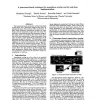Free Online Productivity Tools
i2Speak
i2Symbol
i2OCR
iTex2Img
iWeb2Print
iWeb2Shot
i2Type
iPdf2Split
iPdf2Merge
i2Bopomofo
i2Arabic
i2Style
i2Image
i2PDF
iLatex2Rtf
Sci2ools
99
Voted
ICMCS
2000
IEEE
2000
IEEE
A Panorama-Based Technique for Annotation Overlay and Its Real-Time Implementation
The panorama-based annotation method described in this paper uses a panoramic image as the source of information about the positions of the annotations. It finds image alignment parameters between an input frame and the panoramic image and then maps the positions of annotations from the panoramic image to the input frame and displays the input frame overlaid with those annotations. Camera movement from place to place is made possible by preparing a set of panoramic images in advance. The panoramic image that gives the least mean squares error of the image alignment is selected automatically and is appropriately switched as the camera moves around. The position of the camera can be tracked by monitoring the switchingof selected panoramic images. Experimental results show that this method can find image alignment parameters, display input frames overlaid with the annotations, and switch the panoramic image appropriately in real-time.
| Added | 31 Jul 2010 |
| Updated | 31 Jul 2010 |
| Type | Conference |
| Year | 2000 |
| Where | ICMCS |
| Authors | Masakatsu Kourogi, Takeshi Kurata, Katsuhiko Sakaue, Yoichi Muraoka |
Comments (0)

